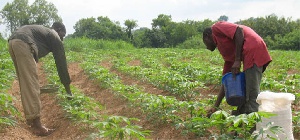Ghana’s population is increasing and a great number of our populace keeps moving to the urban areas. The labour force employed in the agricultural sector is reducing and currently stands at 34%.
It is also known that the contribution of the agricultural sector keeps reducing. All these hindrances coupled with climate change and other environmental issues put pressure on the food security of our country. In our effort to increase agricultural productivity, we apply fertiliser to our lands and crops so as to help us to increase our yields. The idea is to increase our yields, but the current practices are rather causing damage to some lands and crops.
Fertiliser can be explained as any material of natural or synthetic origin that is applied to soils or to plant tissues to supply one or more plant nutrients essential to the growth of plants. Many sources of fertiliser exist; we have both natural and industrially produced.
Farmers turn to fertilisers because these substances contain plant nutrients such as nitrogen, phosphorus, and potassium. Fertilisers are simply nutrients applied to agricultural fields to supplement required elements found naturally in the soil. Fertilisers have been used since the start of agriculture. Native American people used crude fertilisers, such as burying a fish in their corn plots, and organic farmers use fertiliser from natural sources such as compost. Most farmers today use fertilisers that are either mined or manufactured.
Ghana has an agricultural land area of 13,628,178 hectares – representing 57.1% of the total land area, which should be enough to feed its population; yet we have food security challenges.
The use of fertiliser is therefore vital to global food security, but ensuring the right fertiliser is applied is key. In a recent discussion by members of the Chamber of Agribusiness Ghana (CAG), the question of why we apply the same fertiliser to all major agricultural products in Ghana was discussed.
The Chief Executive Officer (CAG), Mr. Anthony Morrison, lamented that the current practice of applying the same dose of fertiliser on, for instance, a maize farm from Volta, Brong Ahafo, Western and all the other regions of Ghana is totally wrong. He stressed that based on the current fertiliser applications practices, it is believed that all soil nutrients in the ten regions of Ghana are the same; and that the contextual, soil acidity, soil porosity, soil aeration, and many other micro and macronutrients are all the same.
Dr. Abu Sakara, who is an agricultural economist and a member of CAG, said fertilizer-use is very expensive and can harm the environment if not used correctly. Therefore, before adding fertiliser, farmers should send soil samples to a laboratory for baseline testing. By testing the soil, farmers will know which nutrients and how much to apply to the soil. If too little is added, crops will not produce as much as they should. If too much is added, or at the wrong time, excess nutrients will run off the fields and pollute streams and groundwater.
So, while fertilisers serve an important purpose, farmers must be careful to use the right amount, at the right time, to avoid potential negative effects on the environment. He further indicated that regardless of the source of the fertiliser, all plants use the same inorganic forms of fertiliser in the soil. Sometimes the source of nitrogen can be plants called nitrogen fixers. Many farmers use crops, such as soybeans and alfalfa (called legumes), that can remove naturally-occurring nitrogen from the atmosphere and place it in the soil for future crops to use.
Dr. Sakara stressed that to stay healthy, humans need to acquire essential nutrients from many different food sources. The demand for food and other products from agricultural systems will increase over the next few decades. This means that we need to keep our soils healthy and full of nutrients in order to feed the growing population.
Also, Mr. Isaac Manu – who is a farm input management consultant and a member of CAG, stated that the way Ghana is handling its soil is quite worrying. He indicated that the increasing use of chemical fertilisers is destroying our soil – and even affecting the quality of food we produce.
Apart from their own long-term effects even when rightly applied, most of our farmers are left alone to use them according to their faith – which is more serious. From the current release of fertiliser prices in 2019, there is no motivation for using organic fertiliser rather chemical fertiliser.
If a farmer requires 1 tonne of compost for an acre and a 50kg bag of compost is now GH¢20, then the farmer requires GH¢400 as compared to GH¢225 for chemical fertiliser. The case is even worse if the farmer wants to use a granular organic fertiliser which requires 16 of the 25kg for an acre which will be (45 * 16 bags) Gh¢¢720 as compared to the same GH¢225 for the chemical fertiliser. However, there is no special market for organic products or no incentive for protecting the soil as a farmer.
Members of CAG stipulated that the greatest single challenge to soil fertility in Ghana and the sub-region is soil mining that accrues from extracting soil nutrients including organic content without replenishment.
This is evidenced by declining soil fertility, including organic carbon content and accelerated soil erosion. While more appropriate fertiliser application of Africa’s average 15kg nutrient/ha is important, we must pay the highest priority to the whopping 100+ kg of nutrients that are extracted annually without replenishment – either in the form of added mineral fertiliser or organic matter.
This yawning deficit of nutrient replacement in combination with soil erosion is the biggest threat to soil fertility. In other words, the greatest loss of money from the soil bank vault are the thieves that rob the bank, not the clerks which make errors in the combination of notes that make up a given sum.
This is just to put the problem of declining soil fertility into perspective. By all means, let us get the right combinations of fertilisers for soils. Let us not, however, diminish the importance of the practice of routinely replacing major nutrients even when we don’t have accurate measures of the magnitude of deficiency. The move toward supporting purchases of fertilisers from in-country blending plants is a great step forward. But we must recognise the spectrum of farmers and their range of fertiliser usage, for which intensive soil testing can be cost-effective.
In our quest to solve national food insecurity challenges and become a zero-hunger country, the chief operations officer of the Chamber, Mr. Evans Brako Ntiamoah, proposes that stakeholders in the sector must make good use of our soil physicists by collaborating with them to study the dynamics of our physical soil components and their phases as solid, liquids and gases on a yearly basis, and then educate stakeholders on the best combinations of fertiliser farmers can apply. Stakeholders should consider establishing fertiliser production firms in the country so as to have a number of companies producing different types of fertilisers.
This will help us to have a variety to choose what can work best for each region, and if possible, each district or municipality. There should be frequent education to our farmers on fertiliser applications. The majority of our farmers have less education in the areas they are farming, and most of them are reactive to agricultural practices.
At least, we must train our farmers on how to examine the farmlands and know which fertiliser can help their crops and livestock. This will help them to demand the right fertilisers and not just any fertilisers being supplied by government. Lastly, a number of soil test-kit technologies have been developed that can be used to test for pH, Nitrogen, Phosphorus, Potash and others that are very vital and can aid farmers in their production. Farmers must invest in these simple technologies to increase their yields.
Business News of Thursday, 28 March 2019
Source: thebftonline.com













